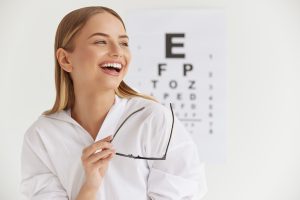The Eyes Have It

The eyes might be the window to the soul but, for ocular doctors, they provide insight into the overall health of the body, too.
“We get a lot of information in a non-invasive way by looking at the vasculature in the eye,” explains Dr. Sarah Eid of Uptown Eyecare. “Is it going to show me how the vessels are in the leg? No, but if a patient is hypertensive, the blood vessels throughout their body show changes—when I see it in the eye, I know it’s in the body. When I see the nerve looking decayed, I might think, ‘Oh no, this patient had a stroke.’ When I see a plaque, I know that there might be a carotid artery occlusion that’s coming their way.”
To get an even deeper assessment of how the health of the eyes and the health of the body are intertwined, it’s not uncommon for eye doctors to consult with the other medical professionals a patient trusts with their care.
“It’s very important to have a multidisciplinary approach to treating patients,” says Nisarg P. Joshi, MD, an ophthalmologist at the Florida Retina Institute. “We can diagnose things that the patient might not know about yet just by looking at the eye and the retina. Then we can communicate with their primary care doctor or their other specialists, and we can work together with them in managing these diseases—and sometimes, the other specialists may depend on our exam to help guide their treatment.”
A range of eye-care professionals recently spoke with Orlando Family Magazine about the stories their patients’ peepers tell about the rest of the body, as well as some exciting advancements benefiting their field and what kind of good habits promote ongoing ocular well-being.
Common Concerns
While the COVID lockdown gave many people pause when it came to keeping up with all manners of regular medical exams, that pattern has largely diminished the farther the peak pandemic recedes into the past. Unfortunately, those interruptions in regular monitoring do have some lingering consequences that eye doctors are still seeing, from advanced cataracts requiring surgery to a noticeable uptick in dry eyes, a condition that is certainly treatable but can damage the tear ducts, increase the risk of infection, create abrasions on the cornea and more if left ignored for too long. A patient’s demographics may also be a factor influencing their eye health, as can the presence of other diseases and health issues.
“The inside lining of the eye that light actually hits and gets converted into a vision signal is a tissue that’s affected by diseases throughout the body, and one of the things we’re starting to see a little bit more of is diabetic-related complications,” observes Gokul N. Kumar, MD, a retinal surgeon at Central Florida Retina. “Those are starting to grow a lot as diabetes itself is growing in number, especially in the South and in Florida. It has a high prevalence in Hispanic and African American populations, but also is widely prevalent in all races throughout the world. We, unfortunately, don’t know the exact factors, but there’s certainly plenty of evidence to suggest there’s diet- and activity-related causes for diabetes.”
Other modern factors are having their own adverse ocular impact. With a meteoric rise in screen time comes a proportional uptick in eye strain that often accompanies the uncomfortable dry eyes born of less-frequent blinking.
“When reading or using computers, phones or [tablets], we blink 60% less,” points out Micha Sassic, regional physician liaison for Central Florida Eye Specialists. “So when your eyes are burning, feel tired and sometimes feel strained, take a break and use over-the-counter artificial tears to refresh them. In severe dry-eye cases, we tend to recommend preservative-free artificial tears along with prescription-form drops for dry eyes, Bruder masks, warm compresses, etc., but it is a case-by-case treatment.”
In addition to Sassic’s suggested remedies, adopting mindful habits can also help counteract the one-two punch of staring at screens during both working hours and off-the-clock scrolling.
“I think that, due to the prevalence of screens in our everyday life, our screen time is excessive,” says Deepak Raja, MD, an ophthalmologist at Remagin. “We usually do tell people that every 20 minutes, they should take a 20-second break and stare at something 20 feet away, just so you don’t get that constant eye strain that Mother Nature never intended, which can really contribute to a lot of dry-eye symptoms.”
Of course, those who know they’re at increased risk for serious eye issues—like extremely near-sighted individuals, whose chances of developing retinal tears are higher than average—should be especially diligent about not only staying up to date on their regular eye exams but also be aware of the signs and symptoms signaling that it’s time for medical intervention.
“Common things that we see as retina specialists are patients with floaters,” Dr. Joshi begins. “These floaters can be associated with flashing lights, usually on the side of your vision—people describe them as camera flashes or like a lightning strike off to the side—which means there’s concern for retinal tear or detachment. So when a patient has these things, it’s important to seek care with their ophthalmologist so they can be evaluated for a tear or detachment because it’s much, much better to diagnose those early.”
Beneficial Breakthroughs
Advancements in diagnoses, treatments and technology continue to punctuate the field of ocular medicine, all promising to improve an array of patients’ quality of life.

“There’s been so much happening in ophthalmology over the past few years,” Sassic notes. “For instance, there’s the IPL [intense pulsed light] laser for dry eyes, and there’s other treatments for dry eyes that focus on the meibomian gland. There’s new technology for cataract refractive surgery to give you the most accurate measurement possible for the best possible visual outcome, which we have at our new Heathrow Surgery Center.”
Given the rise in dry-eye diagnoses and symptoms, it’s perhaps not surprising that many of today’s most remarkable developments are zeroing in on minimizing that issue.
“Dry eye has become such a big problem because a lot of adults now, especially after COVID, are all staring at computers,” says Dr. Eid. “For a long time, it was just, ‘Hey, use some eye drops, hopefully that will resolve your symptoms in the moment.’ But now there’s all this new technology to treat it: We offer one, iLux, that really helps with pushing out the oil in the eye so that way there’s less tear evaporation. We have other tests that can measure the osmolarity of the tears so we know if the quality and integrity of the tears is a problem. We offer drops that promote lacrimal-gland stimulation.”
Helpful Habits
There are some preventive measures the region’s eye-care professionals heartily suggest to both avoid injury and promote optimal ocular health. Contact wearers are emphatically advised to remove and clean their lenses every night, and protective eyewear—from sunglasses in bright conditions to safety glasses for both high-risk occupations and household chores that expose an individual to harsh chemicals or damaging debris—for everyone gets across-the-board recommendations.
“From the context of retinal health, we always encourage a healthy diet and not smoking—those are both factors that have been proven in reducing the rate of macular and retinal disease progression,” Dr. Kumar affirms. “The second thing is protective eyewear. That’s very important for general eye health: We do see lots of injuries just from people working with tools and things that they don’t even recognize as risks, like working with a chemical and you get an accidental splash in your eyes. We always recommend wearing proper eye protection: It can be the difference between a non-issue and multiple surgeries or devastating vision loss.”
Noting that only about half of dry-eye sufferers are diagnosed, Dr. Raja observes that such a staggering statistic is indicative of how necessary regular eye exams are—and how easy they are to take for granted. In addition to the full-body picture the eyes allow for, those who have normalized the discomfort and compromised vision they’ve learned to live with should find some relief and treatment with regular visits to the eye doctor.
“When we do regular eye exams, we do screen for other things, as well, at different layers, so we might—and we do often—catch people who are glaucoma suspects … which is important because once you start getting vision loss from something like glaucoma, we can’t get that vision back,” says Dr. Raja. “People might have preconceived notions of what they think, say, the symptoms of dry eyes are, but might not know that the fluctuating blurry vision they have is actually dry eyes. So if they come in for an exam, we can screen for these things, and maybe it’s an easy fix to make their life better. Sometimes, people don’t know what ‘normal’ is supposed to feel like until we help them feel normal again.”
Leaders in the Field:
Helping to Keep Eyes Healthy
OPHTHALMOLOGY
| Central Florida Eye Specialists Multiple locations (386) 734-2931 | TheEyeSpecialists.com |
Florida Retina Institute Multiple locations (877) 357-3846 | FloridaRetinaInstitute.com |
| Central Florida Retina Multiple locations (800) 255 7188 | CentralFloridaRetina.com |
Remagin Windermere (407) 704-3937 | Remagin.com |
OPTOMETRY
| Uptown Eyecare Hunters Creek and Lake Nona (321) 450-1227 | UptownEyecareGroup.com |
Vision Health Institute Orlando (407) 893-6222 | MyVHI.com |








